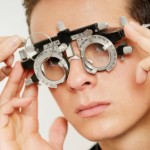These two vision problems stem from the eye not being able to focus light exactly on the retina. The ability to do so is actually quite uncommon and most humans are fractionally long-sighted, fortunately the eye is capable of changing its shape slightly to refocus the light onto the retina for most people. The saying 20-20 vision does not actually imply perfect vision, it implies normal vision – someone whose eye does actually focus light exactly on the retina can achieve better than 20-20 results in an eye test. Fortunately being slightly longsighted does not have much impact on being able to see clearly at most ranges, though it certainly indicates why most people passing the age of 40 start to think about owning a pair of reading glasses.
Hyperopia (Long Sightedness) in Humans
As mentioned above, most people are actually long sighted. However the majority of these are only longsighted to a degree which the eye can automatically compensate. For the rest however, long sightedness means living with the inability to naturally read a newspaper, magazine, or perhaps even focus on a loved one up close. Corrective lenses or laser eye surgery are a common and perfectly workable solutions. The fortunate flip side is that long sighted people can often take in better quality images of distant objects, for example reading a street sign well before someone with 20-20 vision could.
Technically speaking, long sightedness is caused by imperfections in the eyeball, either the eyeball is too short or the cornea is too flat. As a result light waves will focus behind the retina rather than on it, and up close objects will appear blurry. In Severe cases, all vision will appear blurry as the eye does not always have the power to refocus the light waves onto the retina. Long sightedness, like most eye conditions is usually inherited, and can be progressive or stationary. Many people don’t realise that they are naturally slightly long sighted. People progressing to a point where the eye is struggling to naturally compensate may start to experience headaches and tiredness after a lot of visual work – a good sign it’s time to head to an optometrist for a check-up.
Myopia (Short Sightedness) in Humans
Myopia is of course the opposite of hyperopia. Either as a result of having an elongated eyeball or a steep cornea, rays of light focus in front of the retina causing objects at distance to appear blurry. The extent of these effects is measured in ‘diopters’. Categorically, low myopia describes the condition at -3.00 diopters or less, medium between -3.00 and -6.00, and high greater than -6.00. A Diopter is a unit of measurement of the optical power of a lens. Mathematically, a 3 Diopter lens brings parallel rays of light to focus at 1/3rd of a meter.
Essentially the degree of short sightedness in a person will determine at what distance he can still clearly identify objects. For example my vision is blurry beyond a few inches, whereas when I was young, the progressive nature of my myopia was in its early stages; I could comfortably read the blackboard from the back of the classroom. My myopia was assumed to have come on in my childhood, however the onset of short sightedness can come as late as 40 or older, or as young as newborn.
Many studies have found a direct link between increased IQ and myopia. According to Arthur Jensen short sighted people are on average 7-8 IQ points higher than people with normal vision. Confirming this information, China has the highest average IQ and also the highest percentage of short sightedness amongst its population, in fact 80% of the population are at least fractionally short sighted (-0.5 diopters).
A small consolation is that people suffering a reasonable level of myopia are less likely to require reading glasses in old age. This is the major reason why laser eye surgery is less recommended beyond the age of 40.

Long Sightedness Tests & Short Sightedness Tests
Testing for long and short sightedness is a simple matter of visiting your optometrist. Your vision will be tested by your ability to read letters of diminishing size displayed on a wall a few meters from you. If you cannot read letters of acceptable size, lenses of varying strength are placed over your eyes. Lenses of varying strength and type will be tried until your vision is restored to normal and a prescription for glasses or contact lenses is completed.
Correcting Hyperopia and Myopia:
Glasses, Contacts, Laser Eye Surgery
Wearing glasses, contacts, or undergoing expensive laser surgery are the only ways to restore vision to a functional level for both long and short sighted people. There is no natural remedy, and much like color blindness and cataracts, while vitamin A is essential for eye health, no amount of excess vitamin A will restore ones sight to normal vision. It is accepted however that you can undertake ‘stretches for eyes’ to strengthen them. For example by repetitively changing focus between a near and far object, you can strengthen your eye. The result is not to reverse the effects of myopia or hyperopia, but to stall the progression to more severely disadvantaged vision.
You can read more about Glasses and Contact Lenses here and Laser Eye Surgery here.
Hello, can you please post some more information on this topic? I would like to read more.
came here to research on this cuz i promised the one i love that i will tell her much more about it
I found your blog on google and read a few of your other posts. I just added you to my Google News Reader. Keep up the good work. Look forward to reading more from you in the future.